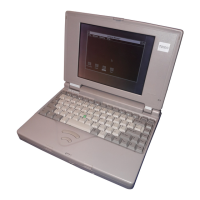
Do you have a question about the Toshiba T2100 Series and is the answer not in the manual?
Details the Intel 486DX2-50 microprocessor's speed and voltage.
Describes internal HDD sizes and the 3.5-inch Floppy Disk Drive.
Outlines standard RAM amounts for T2100/T2100CS and T2100CT models.
Details the T2100's monochrome LCD resolution and grayscale capabilities.
Describes the T2100CS's STN color LCD resolution and color depth.
Details the T2100CT's TFT color LCD resolution and color depth.
Describes the 82/84-key enhanced keyboard and its IBM compatibility.
Lists the main, backup, and Real Time Clock (RTC) batteries.
Details the two PCMCIA slots and their supported card types.
Covers parallel, RS-232-C, keyboard, port replicator, and external monitor ports.
Explains the slot for installing optional Toshiba memory modules.
Describes the pointing control stick located on the keyboard.
Details the monochrome LCD specifications like resolution and contrast.
Specifies input/output voltage, power, current, and frequency for the inverter board.
Details the STN color LCD specifications like resolution and contrast.
Specifies input/output voltage, power, current, and frequency for the STN inverter board.
Details the TFT color LCD specifications like resolution and contrast.
Specifies input/output voltage, power, current, and frequency for the TFT inverter board.
Describes the main battery as the primary power source and its indicator.
Details the backup battery's charging time and data preservation period.
Provides a flowchart for determining troubleshooting steps.
Guides on checking AC IN LED and Battery LED indicators.
Covers message checks, LED checks, and diagnostic test execution.
Details FDD head cleaning, diagnostic tests, and connector checks.
Covers partition, message, format, and diagnostic test checks for HDD.
Guides on keyboard diagnostic tests and connector checks.
Includes contrast, external CRT, diagnostic tests, connector, and replacement checks.
Instructions on starting and running the diagnostic program.
Details ROM checksum and hardware status checks.
Covers constant data, address pattern, refresh, and protected mode tests.
Explains pressed key display, scan code, PS/2 mouse, and pointing stick tests.
Covers VRAM, character attributes, graphics modes, and display page tests.
Details sequential read, random data, and specified address tests.
Covers ripple pattern, function, and wraparound tests for printers.
Details sequential read, address uniqueness, and cross talk tests.
Lists error codes and their corresponding status names for diagnostics.
Explains low-level and MS-DOS formatting options for HDDs.
Automates sequential execution of system, memory, display, FDD, HDD, and printer tests.
Displays BIOS, Boot ROM, KBC, PS Micom versions, and hardware configuration.
Allows configuration of memory, display, battery, hard disk, and I/O ports.
Overview of FRUs and removal sequence.
Essential steps and safety measures before disassembling the computer.
Lists necessary tools like screwdrivers and ESD equipment.
Step-by-step instructions for removing and installing the battery pack.
Procedures for removing and installing optional memory modules.
Detailed steps for removing and installing the computer keyboard.
Instructions for removing and installing the hard disk drive unit.
Procedures for removing and installing the system board and batteries.
Steps for removing and installing the computer's display mask.
Instructions for removing and installing the LCD module.
Steps for removing and installing the Fluorescent Lamp inverter board.
Procedures for removing and installing the T2100CT LCD module.
Steps for removing and installing the T2100CT Fluorescent Lamp.
